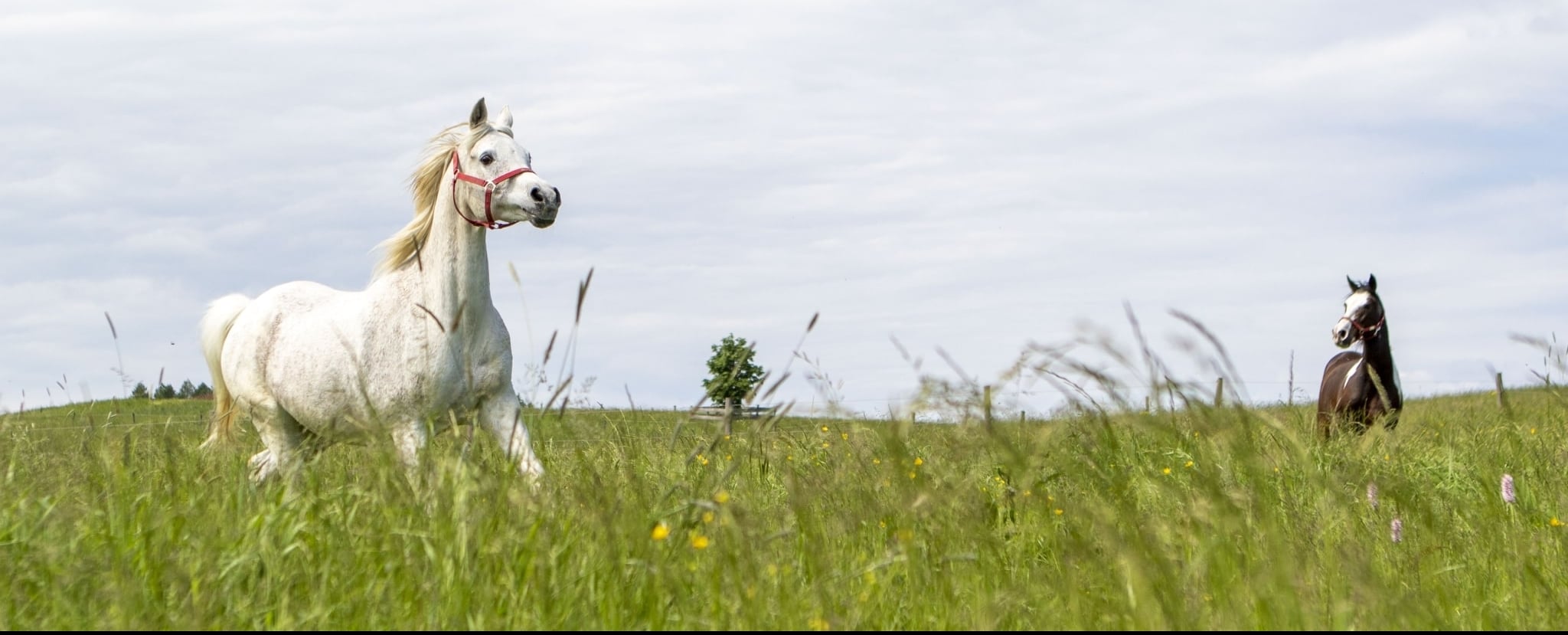
Knowledge deployment
Latest research results, successfully implemented
Parasite infestation is a constant challenge for all those responsible for animal husbandry. In the case of grazing animals, gastrointestinal worms take centre stage from an animal health perspective. Inadequate control can result in serious illness and even death. Carefully planned and implemented parasite management is therefore very important. Parasite-free grazing animals are unthinkable in practice – but the good news is that not every detection of parasites is a cause for concern and a reason for deworming, as healthy animals can live very well with a moderate infestation and this treatment can even have positive effects on the immune system. Two projects are used to illustrate how Gut Aiderbichl uses a progressive approach to parasite management in horses, donkeys, sheep and goats.
Parasite monitoring in equidae
Basis/starting point: Parasite infestation is a constant challenge for animals. In horses, donkeys and mules, gastrointestinal worms are at the forefront from an animal health perspective. Inadequate control can lead to serious illness and even death. Parasite management of all equines living at Gut Aiderbichl is therefore very important. A parasite infestation can be diagnosed via a faecal examination, but not every parasite detection is a cause for concern and a reason for deworming. Healthy animals can live very well with a moderate infestation and this treatment can even have positive effects on the immune system. Until 2019, parasite control of the equines at Gut Aiderbichl was carried out at most locations through regular deworming at three or four points in the season.
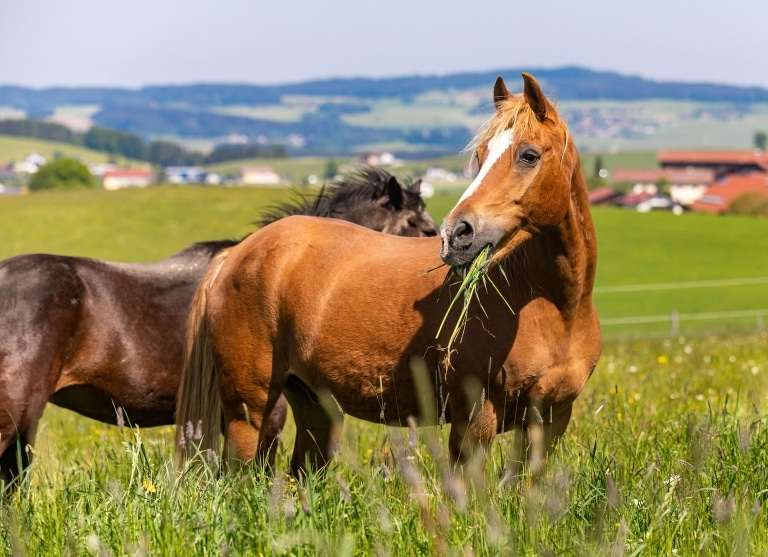
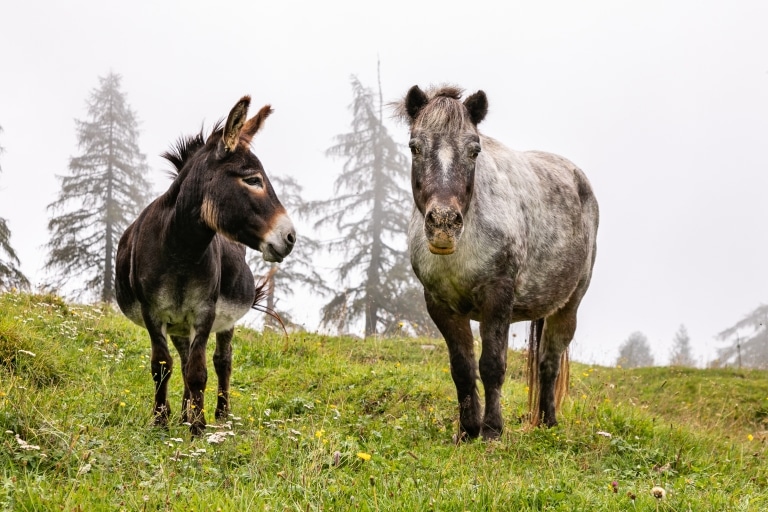
Goal: In light of the worsening global problem of resistant parasites, a gradual reorganisation of parasite management for GA’s equidae was initiated in 2020. With the introduction of a selective deworming concept based on the Swiss model, the aim is to deworm equidae in future only as required on the basis of a prior faecal examination. The aim of reducing the use of medication is to avoid unnecessary stress on the animals and to protect their environment as a result of excreted drug residues. The deworming of horses with an increased excretion of parasite eggs, which is still necessary, prevents further contamination of the grazing areas if carried out quickly and thus reduces subsequent infections of other horses.
New findings: In the first year of monitoring (2020), only around 20% of the almost 1,000 faecal examinations carried out at the six sites initially included in the study yielded results that required deworming. Based on this, a further reduction in the deworming rate of 22% was recorded at the same sites in the following year. This is already an initial indication of the considerable potential of monitoring to reduce treatment intensity in the future.
Outlook: As parasitological equine monitoring is an „open-ended“ project, new findings will be made every year. Ongoing evaluation and, if necessary, optimisation of the monitoring are essential and ensure continuous development. The latest findings and developments can be found here.
Publication: Magazine „Leben Lieben“ – Spring 2022
Project management: PD Dr Hubertus Hertzberg
Parasite monitoring in small ruminants
Basis/starting point: Infestation with gastrointestinal worms is one of the main problem areas in sheep and goats from an animal health perspective. Sheep and goats only develop very weak immunity to the parasites, meaning that not only young animals but also adult animals can fall ill and must therefore be included in the control measures. Parasite management is therefore very important. Faecal examinations offer a very good opportunity to diagnose the extent of parasite excretion in individual animals. A low-grade infestation can be well tolerated by a healthy animal. At the GA sites, where increased parasite contact for the sheep and goats is to be expected due to the more extensive pasture contact, diagnosis-based parasite management has been carried out since 2021, which also includes the South American camelids and dromedaries at the main Henndorf estate.
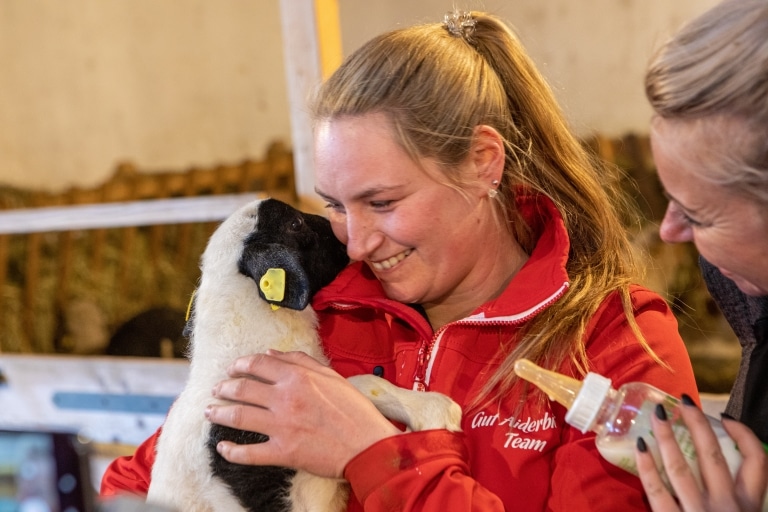
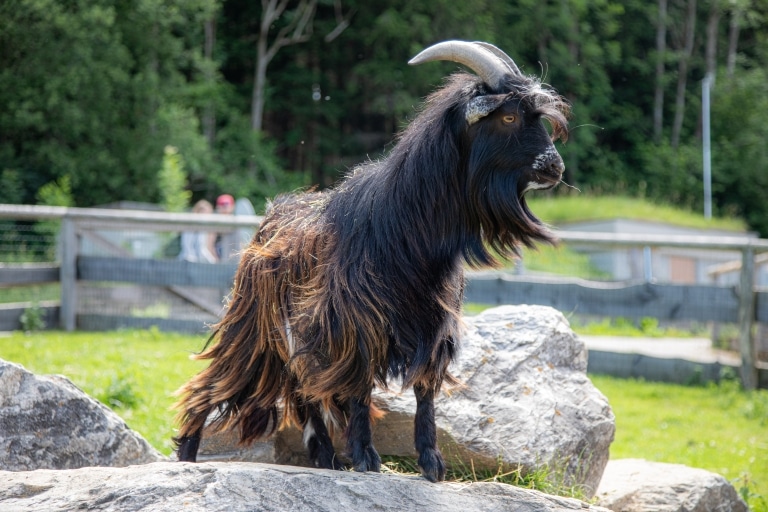
Objective: The rapidly advancing problem of resistance to gastrointestinal worms worldwide necessitates a reorientation of parasite management in small ruminants. For the animals at Gut Aiderbichl, the aim is to switch from routine treatments to a needs-based control programme in the medium term. The prompt implementation and subsequent review of the treatments will counteract further contamination of the green areas with parasite stages and reduce subsequent infections of other animals. The aim of reducing the use of medication is to avoid unnecessary stress on the animals and to protect their environment as a result of excreted drug residues.
New findings: Experience to date – which is currently still limited – shows that the parasitological burden of individual sheep and goats can vary greatly, even within a group, and that targeted selection of animals worthy of treatment would therefore be desirable with a view to reducing the use of medication. This is also in view of the initial observations, which indicate considerable limitations in the effectiveness of the dewormers used at individual locations.
Outlook: The experience gained at the previous sites forms the basis for extending parasitological monitoring to other sites.
Project management: PD Dr Hubertus Hertzberg
Sandgrueb Foundation rehabilitation centre for equines
Basis/starting point: Equines with serious diseases pose emotional, financial and medical problems for pet owners, especially when it comes to diseases for which no established therapy is available. The illnesses also often affect old horses, which in turn means that they are more frequently relinquished or even create animal welfare situations. Unfortunately, this often results in owners being overwhelmed, which can lead to neglect, relinquishment or even death of the animals.
On behalf of Gut Aiderbichl, sthe Sandgrueb Foundationtakes special care of these animals. At the rehabilitation centre in Egg near Zurich wa considerable effort is made to alleviate the underlying suffering. However, this is a very difficult task due to the frequent lack of treatment options. In collaboration with the Vetsuisse Faculty of the University of Zurich and Vetmeduni Vienna, intensive efforts are being made to continuously improve the quality of life of rescued animals and develop effective therapies.
The diseases to be treated can be very diverse, but some stand out in terms of both frequency and impact on quality of life, namely chronic lameness, sarcoids and other tumours (e.g. melanomas), hoof cancer, recurrent hoof abscesses, chronic progressive lymphoedema (CPL) in cold-blooded horses, equine metabolic syndrome (EMS), equine Cushing’s disease, laminitis and dental diseases, to name but a few.
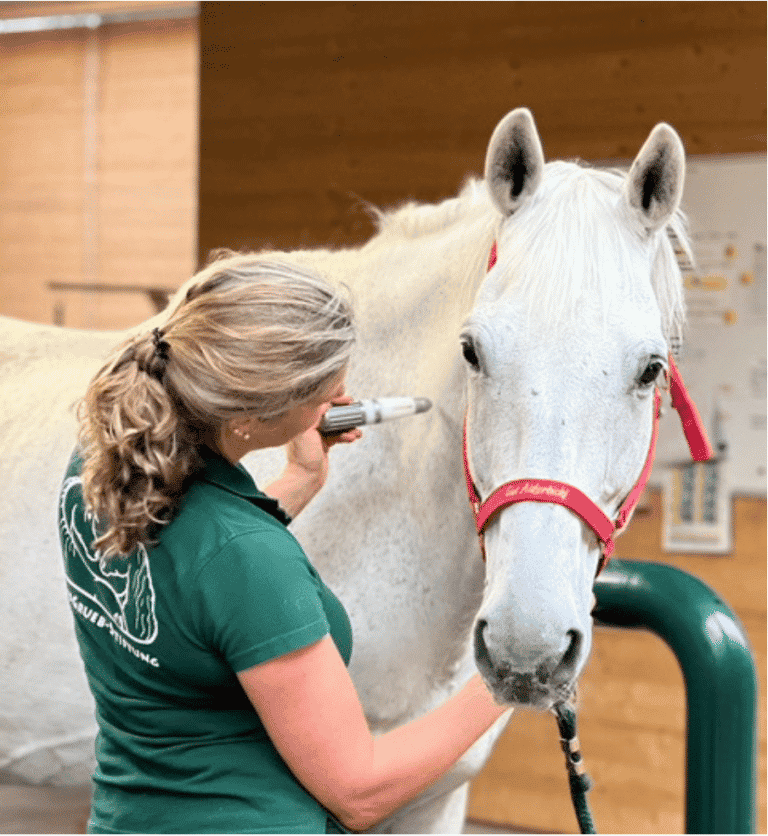
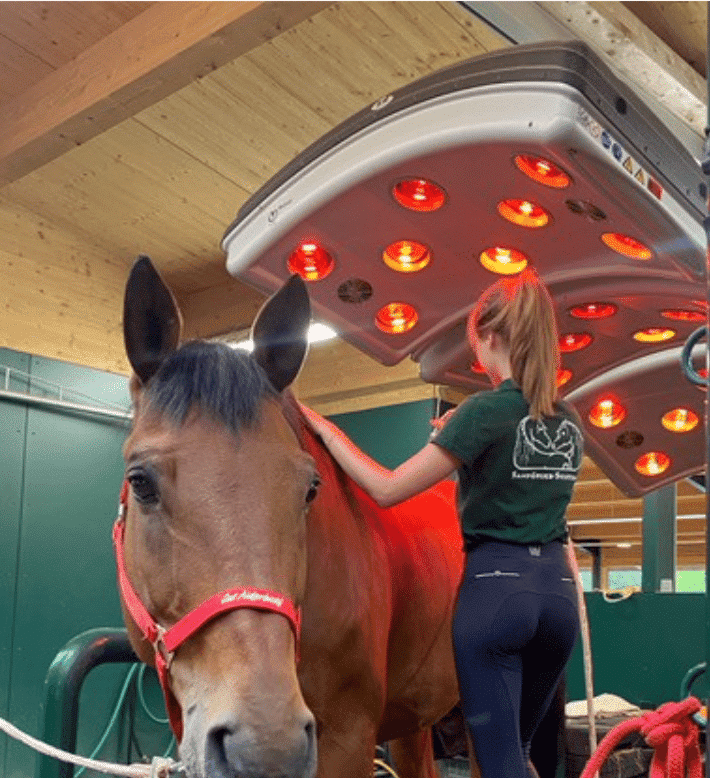
Goal: The rehabilitation centre focuses on a holistic approach to therapy. In addition to physical healing, the mental well-being of the horses is also important. Loving care and support, as well as a warm approach to the horses, in which a lot of time is taken for each patient, is essential. Healing is based on a combination of a healthy psyche, veterinary treatment, balanced feed and exercise. Contact with conspecifics is also particularly important.
The aim is to treat diseases successfully and in a targeted manner and to develop new treatment methods, especially in areas where no therapies are established. A further focus is on individualised palliative therapy to improve the quality of life of terminally ill animals.
Sick horses with difficult-to-treat problems that require intensive care receive continuous veterinary support and care in the rehabilitation centre.
Intensive work is being done on the development of easy-to-apply therapeutic approaches, as effective and easy-to-implement treatment options need to be found quickly for the more than 700 horses at Gut Aiderbichl. Furthermore, the knowledge gained here can be extended to a wider public in the future in order to raise awareness of diseases, e.g. in ageing and chronically ill horses, and thus enable earlier treatment to be started – so that suffering either does not occur in the first place or can be reduced at an early stage.
New findings: In addition to conventional medicine, the rehabilitation centre also relies on alternative, but medically sound treatment methods.
The Vetdrop® treatment has been very successful to date. The treatment involves the application of concentrated oxygen enriched with natural and pharmaceutical substances (e.g. urea, hyaluronic acid, essential oils) and allows this mixture to penetrate into deeper layers of tissue. In addition to painful arthrosis or tendon injuries, inflammation or acute or chronic wounds can also be treated.
The team has also achieved very good treatment results with the disinfectant and anti-inflammatory effect of a disinfectant solution (Xeron®) based on a highly effective hypochlorous acid (HOCL). This is acidic or neutral water with a pH value of 4.7 or 7.0. The water acts against viruses, bacteria and fungi through oxidation. It is successfully used to treat acute and chronically infected wounds, in the form of sprue dressings for phlegmons and deep skin infections, mastitis, thrush and much more.
Outlook:In cooperation with Gut Aiderbichl, the rehabilitation centre can be a further training centre to train Gut Aiderbichl employees and familiarise them with the new treatment methods. Furthermore, the rehabilitation station is a centre for the medical care of particularly seriously ill and treatment-intensive horses at Gut Aiderbichl.
Project management: Dr.med.vet. Karina Klein, DVM-PhD, Animal Hospital Zurich
Close-to-nature husbandry is the most species-appropriate way for animals to live. At the same time, it is sustainable and offers the greatest opportunities for preserving biodiversity. Horses that spend day and night in the pasture organise their daily routines very differently to those in human-controlled husbandry systems. Healthy feed is always available in the wild, allowing horses to avoid unfavourable weather conditions and insect infestations. Unfortunately, many equidae can no longer live freely on pasture today because they are threatened by diseases of affluence. Various projects at Gut Aiderbichl are therefore concerned with the composition of the forage grass areas, their optimisation with suitable seed and the quality of the hay obtained from them. The forage areas are the basis for natural husbandry and thus for the mental and physical health of the animals.
Composting
Basis/starting point: On average, a horse produces between 20 and 30 kg of manure per day, which corresponds to around 7 to 10 tonnes or 20 to 30 m³ per year. These are large quantities of manure that a stable has to manage. This manure contains large quantities of nutrients which, if handled correctly, can close the material cycle. However, it can also contain pathogens, parasites or weeds that you do not want to spread. Therefore, an appropriate and economically justifiable valorisation of the manure should be considered.
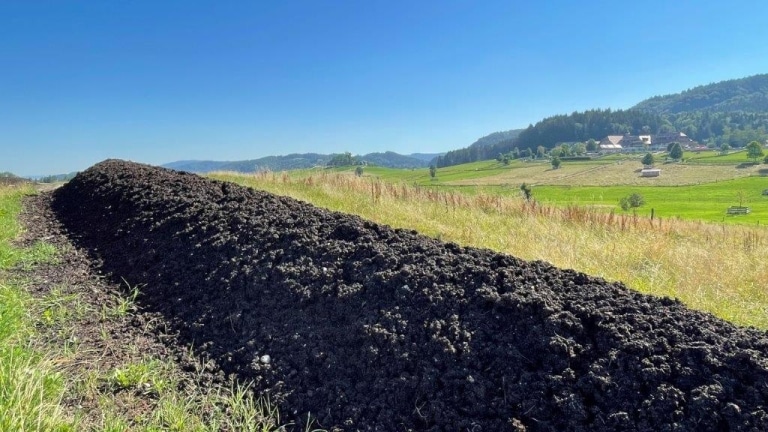
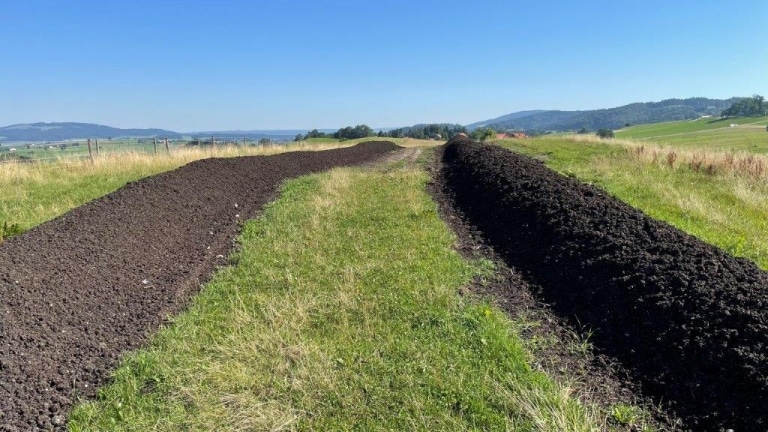
Goal: The aim of this project is to set up an optimised composting system at Gut Aiderbichl for the treatment of horse manure. A quality concept, ranging from the collection of the manure to the management of the process itself and the utilisation of the compost produced, will accompany this project. A threefold reduction in volume can already be observed during composting. The compost produced can therefore be stored and used at the ideal times for meadows. In addition, a natural „hygienisation effect“ of the manure is achieved during the composting process, as the temperature of the material reaches up to 65°C. Compost that is not needed must be of impeccable quality in order to be placed on the market, especially for hobby gardeners. To achieve this goal, Gut Aiderbichl employees are trained in composting.
New findings:Field-side composting is used to treat the manure. It is optimised for the different situations on the selected Gut Aiderbichl farms, depending on the type of bedding and the organic by-products available. In parallel, a study can be carried out on the inactivation of pathogens, parasites and weeds during the composting process.
Outlook: Based on the results obtained during the project, a guideline will be developed to serve as a basis for implementation on other farms. This guideline will not only deal with the management of the composting process itself, but also with the utilisation of the quality compost produced. An economic evaluation of the concept will round off this project.
Project management: Dr Jacques Fuchs, FiBL Switzerland
Grassland
Basis/starting point: The most important grass for the economy in Europe is German pasture grass. It is found in standard seed mixtures for horse pastures and horse hay meadows. It is particularly important in dairy farming because it is rich in energy and protein. Horses and donkeys, however, can get by with minimal nutrition and can achieve maximum exercise performance. These genetics, which were a prerequisite for the selection of ancestors, are now a threat to our horses due to diseases of affluence, in particular those of the ponies. In addition to obesity, severe metabolic disorders occur over the years, comparable to diabetes in humans, which lead to life-threatening diseases such as laminitis in horses. A reduction in feed can lead to digestive disorders and inflammation of the mucous membranes of the digestive tract. Short-grazed runs are also not an alternative, as they represent a selection for unhealthy plants.
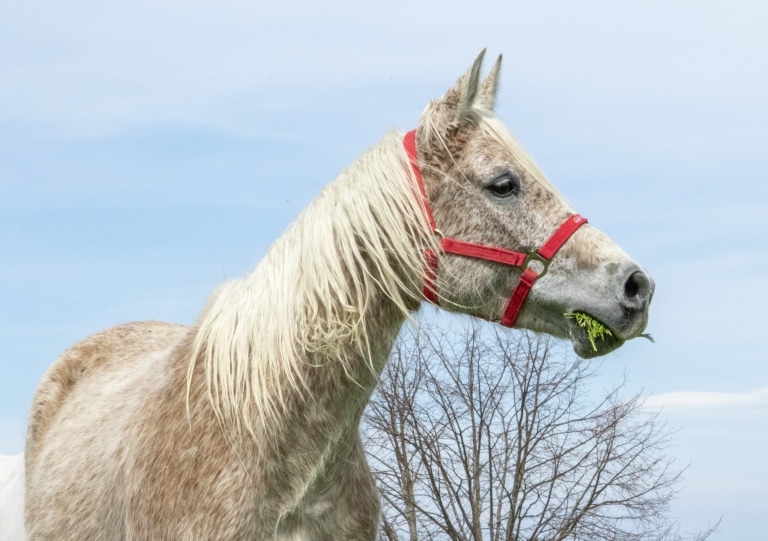
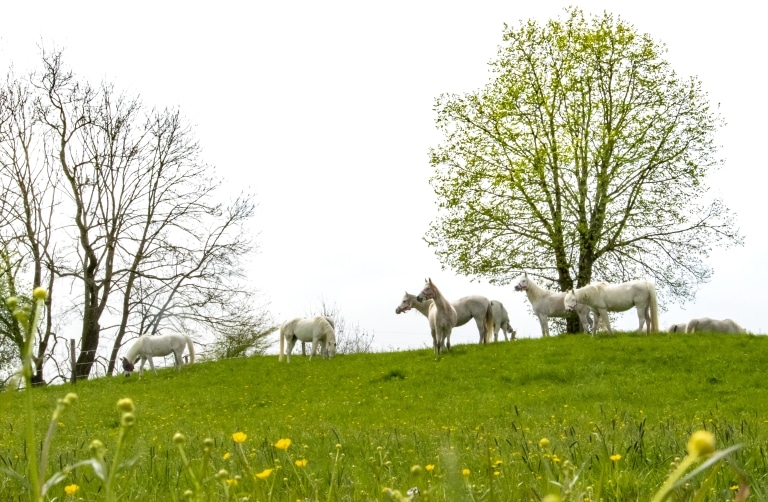
Target: The Gut Aiderbichl farms have grasslands with very different vegetation. At the same time, there are different requirements for the feed, depending on the animals‘ state of health. Since 2021, the vegetation on the farms has been recorded to see which grasslands are suitable for old horses and which are less so. Areas that are too rich are to be changed to a healthier forage basis. Horses and donkeys threatened by obesity need old permanent grassland consisting of low-yielding wild grasses and wild (medicinal) herbs. The plant composition reflects the location with its soil, weather and utilisation. Each farm will develop its own individual composition, which in turn is intended to feed the animals in a targeted manner so that they can live an optimally healthy life.
New findings: In Trevol (France) and Szepalma (Hungary), the soils and climate make it possible to create species-rich semi-arid grasslands. This herb-rich vegetation is considered particularly healthy for sensitive robust horse breeds. The Aiderbichl Iffeldorf Estate (Germany) could harvest large quantities of raw fibre-rich, low-energy hay from meadow foxtail meadows. The valley meadows at Gut Aiderbichl Henndorf (Austria) offer a small-scale mosaic of very different compositions. There are even meadows rich in orchids and acid grasses around a small bog of peat moss and cotton grass.
Outlook: Gut Aiderbichl is breaking new ground. Such diverse areas under one roof are unique and allow for research into the connections between feed basis and animal health, which could be groundbreaking for the horse husbandry of the future. We will report on this here.
Publication: Link to
Project management:
Seeds
Basis/starting point: The seed mixtures for horse pastures and hay meadows on the market are based on the so-called standard mixtures for horses and are species-poor. The high-performance grasses used in these mixtures are forcing the impoverishment of the flora and fauna on horse owners‘ grasslands. High-performance grasses produce growths (a coating of microorganisms) that are significantly richer in energy than the landscapes from which horses and donkeys originally come. A scientific study from 2020 also revealed that around one in four to five commercialised seed mixtures for grassland are infected with fungi known as endophytes. These fungi give the sown green grass the desired special resistance to drought, nutrient deficiency and overgrazing.
The „host grasses“ of the fungi are pasture grass and fescue. Some of the fungi’s active ingredients are particularly toxic to horses, as these toxins act like endocrine disruptors.
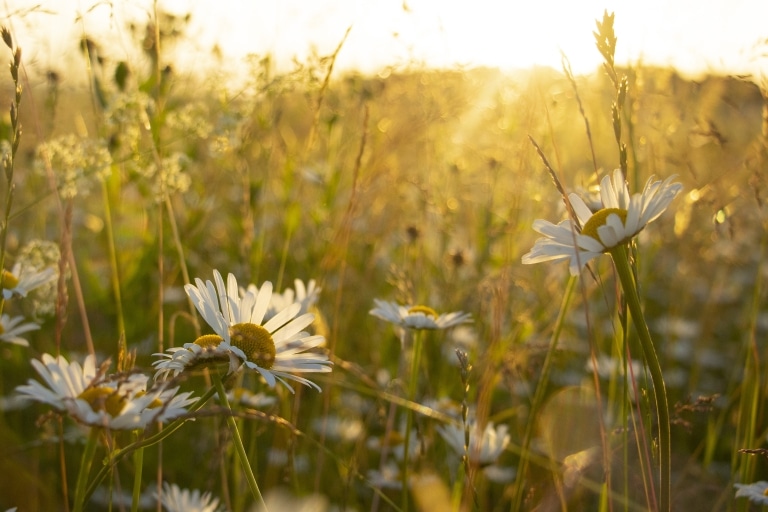
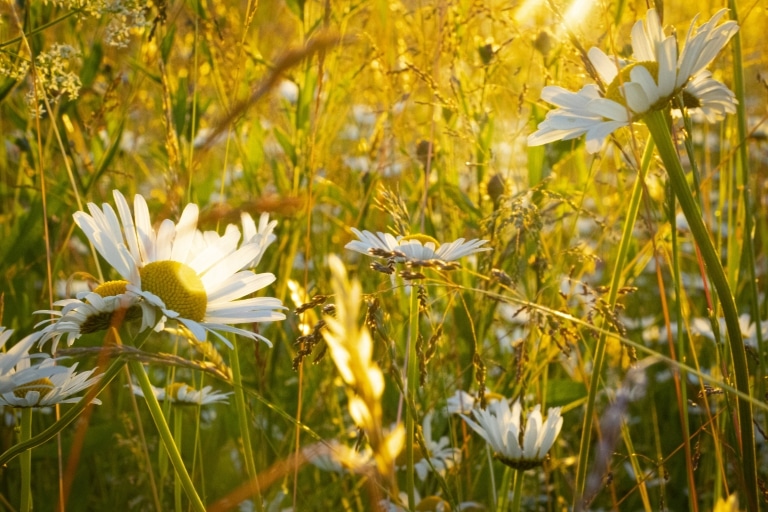
Goal: Gut Aiderbichl wants to take precautions. The grassland located in six different European countries is being tested for the presence of these fungi. Instead of continuing to use farmed seed from the trade, the aim is to interrupt pathways of introduction and close cycles. To this end, suitable donor areas in the immediate neighbourhood are being sought on our own farms. Gut Aiderbichl wants to obtain its own wild seed from grasslands that are proven to be non-toxic and suitable for horses in terms of their plant composition. Harvested as a mulch cut at maturity, the growth from the donor area can be used as a seed transfer to supply patchy areas with seeds and increase the diversity of species-poor areas. In addition, the aim is to increase biodiversity through the use of regional wild seed in co-operation with state institutions.
New findings: The areas at Gut Aiderbichl are largely free of toxic endophytes. Areas with high livestock numbers and constant hay feeding show high seed inputs, including from plants that are not typical of the site. Purchased hay contains seeds that pass through the digestive tract undamaged. They reach the land with the nutrient-rich manure and germinate. Manure is an often overlooked source of seed dispersal. For livestock farmers, areas of high species diversity are not recognisable. Vegetation surveys carried out by experts are therefore essential if seed treasures are to be unearthed and losses of rare plants avoided.
Outlook: Ecosystems are dynamic. They are subject to constant influences and changes. Continuous monitoring of the forage base by experts helps to recognise undesirable changes in good time. In addition to the invasion of dangerous poisonous plants and easily overlooked poisonous fungi into the forage areas, this applies in particular to the impending loss of biodiversity.
Publication: Link to
Project management:
Hay quality
Basis/starting point: The energy content of hay is also far too high for many horses and donkeys. Of all things, the hay that is the best according to all the criteria that horse owners learn has the highest energy content. The Austrian Working Group for Grassland and Livestock Management (ÖAG) states that the hay that is judged to be the best hay according to all guidelines and that almost all horse owners strive for is suitable for „top horses in sport and breeding“. For robust breeds (e.g. Noriker, Haflinger), hay batches with less than half the achievable number of points in the assessment are seen by the ÖAG. The horses at Gut Aiderbichl therefore require a completely different type of hay to the hay given to sport horses in riding stables. To make matters worse, the teeth of old horses become increasingly worn down. These animals can then no longer chew coarse roughage.
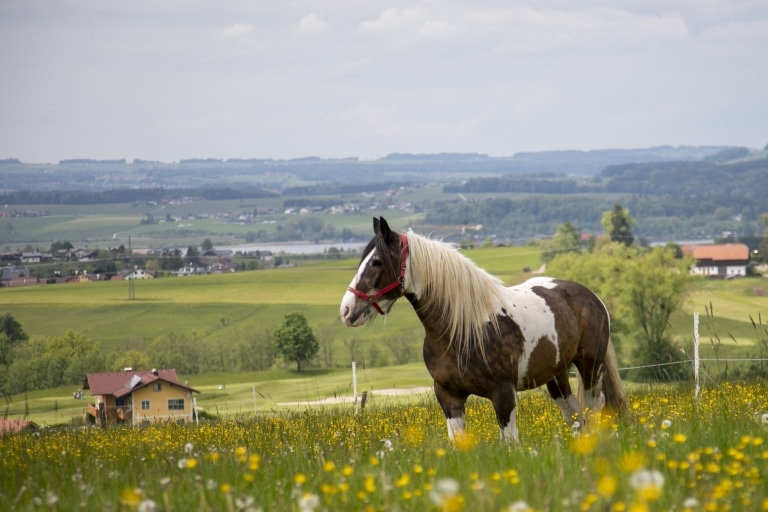
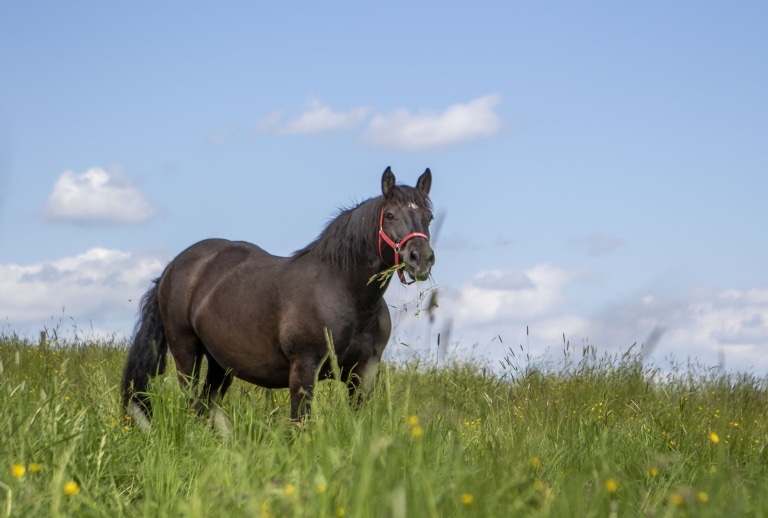
Goal: Aromatic, fragrant hay of a green colour, rich in leaves and not too coarse, can only be fed to many horses on a rationed basis. However, long breaks in feeding can provoke mucosal ulcers in the stomach and intestines and are therefore relevant to animal welfare. Eating slowly over a long period of low-energy growths is a goal to be strived for in many horses.
New findings: Gut Aiderbichl wants to check the quality of each individual bale in the hay field and establish traceability by labelling it. The development of each bale is fully documented in a log: Hay area, time of cutting, temperature history, residual moisture etc. This information will show where there are problems that need to be rectified. At the same time, samples of each batch of hay are sent in for laboratory analyses to confirm the energy and protein content as well as any fungal infections.
Outlook: The hygienic quality requires low-dust hay, free from moulds and toxins. Delicate herb leaves contain many minerals, proteins and herbal active ingredients of medicinal herbs, which are particularly valuable for old and sick animals. This is a wide field of experimentation that will yield exciting results!
Publication: Link to
Project management: